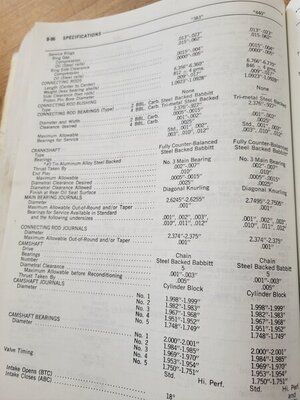Challenger340
Well-Known Member
- Local time
- 10:48 AM
- Joined
- Mar 4, 2014
- Messages
- 857
- Reaction score
- 977
- Location
- Moyie Lake, B.C. Canada
* NEVER attempt to polish a Crankshaft more than "maybe" a TEN-Thousandth or so.... and certainly NOT as a way to gain more bearing clearance.
You GRIND the Crankshaft to LOWSIDE.... then Polish to provide surface finish only.
When Blueprinting for HP Street or Racing Engines
* By GRINDING the Crank to LOWSIDE or SMALL side of the tolerance, you allow yourself extra .001" "room"... to then "SET".... or "ADJUST" the Bearing Clearances according to the intended application when ReSizing the Big Ends of the Con Rods(or main W/Line Honing).... by either ReSizing the Rods to the "Small" or conversely "Big" end of their size tolerance range(typically .0005").
Remember here.... because of Bearing eccentricity which is built into the Bearing shells....
and
the effects of Bearing "Crush" when the Bearing is Torqued up in the Con Rod(or Main).... the INCREASE or DECREASE in Bearing Clearance is NOT linear UP/DOWN as either the ConRod Big End or Main Cap size is opened/closed within tolerance. That typically .0005" Rod Big End or Main cap Size tolerance when adjusted can see actual "vertical" Bearing clearances move .0007"/.0008" UP/DOWN as the "Crush" under Torque is applied.
In this case for this type 440.... by very simply following instructions and grinding the Crank LOWSIDE.... and sizing everything else Rod Big Ends/Mains "midsize" as is common practice at farm implement/NAPA shop syle houses .... you will end up right around .003+" mains and .0025" Rods.
The actual Crank GRINGING to lowside one of the hardest things to get Farm Implement/NAPA style Machine Shops to do.... don't ask me why but it is.... because they just can NOT seem to wrap their Heads around pressure/rpm/load/cushion effect Oil requirements for High Performance ?
You GRIND the Crankshaft to LOWSIDE.... then Polish to provide surface finish only.
When Blueprinting for HP Street or Racing Engines
* By GRINDING the Crank to LOWSIDE or SMALL side of the tolerance, you allow yourself extra .001" "room"... to then "SET".... or "ADJUST" the Bearing Clearances according to the intended application when ReSizing the Big Ends of the Con Rods(or main W/Line Honing).... by either ReSizing the Rods to the "Small" or conversely "Big" end of their size tolerance range(typically .0005").
Remember here.... because of Bearing eccentricity which is built into the Bearing shells....
and
the effects of Bearing "Crush" when the Bearing is Torqued up in the Con Rod(or Main).... the INCREASE or DECREASE in Bearing Clearance is NOT linear UP/DOWN as either the ConRod Big End or Main Cap size is opened/closed within tolerance. That typically .0005" Rod Big End or Main cap Size tolerance when adjusted can see actual "vertical" Bearing clearances move .0007"/.0008" UP/DOWN as the "Crush" under Torque is applied.
In this case for this type 440.... by very simply following instructions and grinding the Crank LOWSIDE.... and sizing everything else Rod Big Ends/Mains "midsize" as is common practice at farm implement/NAPA shop syle houses .... you will end up right around .003+" mains and .0025" Rods.
The actual Crank GRINGING to lowside one of the hardest things to get Farm Implement/NAPA style Machine Shops to do.... don't ask me why but it is.... because they just can NOT seem to wrap their Heads around pressure/rpm/load/cushion effect Oil requirements for High Performance ?
















